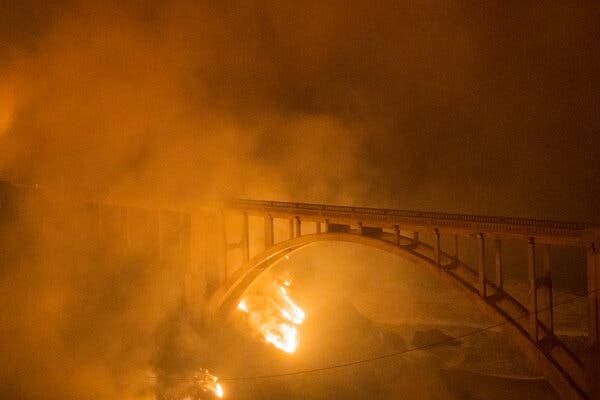The National Weather Service called the fast-moving blaze “surreal,” given the recent storms.
A fire in January? Californians have, tragically, seen that before.
But a fire in January after months of record-breaking rain? That’s far more unsettling.
A blaze that erupted on the Central Coast over the weekend seemed to stun even those intimately familiar with California’s ongoing drought and its increasingly year-round fire season. The National Weather Service’s Bay Area office called the fast-moving fire near Big Sur “surreal,” given the recent storms.
California saw heavy rainfall in the final three months of 2021, leading many to believe that the threat of fire would lessen for at least the next few months. But the latest blaze revealed a harsh reality: The drought has become so severe that even a series of torrential storms wasn’t enough to end it.
The land in many parts of the state remains extremely parched and, after an unusually dry January, apparently ready to burn.
“Anecdotally, it seems as though the long-term drought is acting like a chronic illness where even recent rains” and cold winter weather “isn’t helping to keep fires from developing,” the National Weather Service’s Bay Area office said on Twitter.
On Friday night, the brush fire near Big Sur began to grow, forcing hundreds living in a coastal stretch south of Carmel-by-the-Sea to evacuate their homes. At its largest over the weekend, the blaze reached about 1,000 acres and threatened more than 200 homes and buildings. By Monday morning, it was 33 percent contained, according to Cal Fire, the state’s fire agency.
George Nuñez, a captain with Cal Fire, told my colleague that he had to ask other agencies to help fight the blaze because it hit during the off-season.
Typically, his unit has 17 fully staffed fire engines, he said. But that number was reduced to two when fire season officially ended in early January, he said.
“Everybody says that California has a year-round fire season,” Nunez told The New York Times. “And this is just part of it.”
Last year, California endured a brutal fire season triggered by unusually high temperatures and severe drought conditions. By the end of 2021, 2.6 million acres had burned across the state, a million more the annual average from the past five years, according to Cal Fire.
Almost all of last year’s destruction happened before a series of storms arrived in October and dumped water across the state. Another series of downpours in December made California seem even safer from fire.
Before the storms, 88 percent of California was considered in extreme or exceptional drought, the most severe designations. Now, 1 percent of the state falls into those categories, according to the U.S. Drought Monitor.
But apparently the improvement wasn’t enough to stop fires all together. Even after the storms, 99 percent of California remains in some level of drought.
And January, usually one of the wettest months of the year, has been unseasonably dry. For the past three weeks, plants and soil have been losing much of the moisture they absorbed in late 2021.
So when humidity levels dropped on Friday and winds began roaring at up to 50 miles per hour near Big Sur, dangerous fire conditions were set.
“It’s unusual to have fire this size here on the coast at the end of January,” Cecile Juliette, a spokeswoman for the California Department of Forestry and Fire Protection, told The Associated Press. “The fact that we had a fire this size is of great concern.”
For more:
-
Why does California have so many wildfires?
-
How do wildfires get their names?
-
Vice President Kamala Harris was in California on Friday highlighting new funding for federal wildfire programs.
The latest on the coronavirus pandemic
-
Inside the setbacks of President Biden’s first year fighting the pandemic.
-
Starting Monday, students in Los Angeles must wear higher-grade face masks.
-
Olympians face a daunting final qualifying event: staying healthy.
-
The latest coronavirus case map of the United States.
The rest of the news
-
“Why was I born a girl?”: A poem by an 11th grader in Kabul is inspiring students in San Diego.
-
Youth vaccination: A newly proposed bill would allow children age 12 and up to receive a Covid vaccination without their parents’ consent, The Associated Press reports.
-
Single-payer proposal: The health care reform debate could be reignited across the U.S. as California weighs a single-payer health care system, ABC reports.
-
Bear hunting: The Humane Society of the United States is petitioning to stop bear hunting as wildlife populations dwindle, The Sacramento Bee reports.
-
Motherhood: The pandemic has offered some women a choice they never had before: to keep their pregnancies secret till the very end.
SOUTHERN CALIFORNIA
-
V.I.P. crash: Arnold Schwarzenegger walked away with minor injuries after a four-car crash occurred in Los Angeles, The Associated Press reports.
-
“I Crashed My Plane”: Almost immediately after a YouTuber posted a video jumping out of a small aircraft before it crashed above the Los Padres National Forest, viewers and aviation experts expressed doubts.
-
Urban oil wells: Los Angeles is considering banning new oil wells and phasing out existing ones, The Associated Press reports.
CENTRAL CALIFORNIA
-
School lawsuit: A mother who claims teachers manipulated her 11-year-old daughter into changing her gender identity is suing a school district in the Salinas Valley, The Associated Press reports.
NORTHERN CALIFORNIA
-
Wine insurance: Outdoor businesses such as farms, ranches and wineries will be eligible for last resort insurance beginning Feb. 1, The Associated Press reports.
Where we’re traveling
Today’s travel tip comes from Vivia Strome, who recommends Armstrong Woods:
“Just about an hour or so north of the famed Muir Woods, in Guerneville, lies another park where you can enjoy a mild hike with family.
Your senses are refreshed with the cool damp air while you gaze at the massive majestic and magical Redwood trees that hover above reaching for the ocean blue sky and the bright winter sun.”
Tell us about your favorite places to visit in California. Email your suggestions to CAtoday@nytimes.com. We’ll be sharing more in upcoming editions of the newsletter.
What we’re reading
The winners of our student personal essay contest.
And before you go, some good news
Meet Raymie, a 154-pound newborn.
Raymie was born last week at the Santa Barbara Zoo and clocked in at 5 feet 9 inches tall, The Santa Barbara Independent reported. Just 45 minutes after he was born, the little guy was able to stand up on his own.
Raymie is a Masai giraffe, a subspecies of giraffe native to Kenya and Tanzania that was declared endangered in 2019. Their population has fallen by half over the last three decades.
Raymie and his family — he has a sister who was born in 2020 at the zoo — are among an estimated 120 Masai giraffes that live at 28 North American zoos, the news outlet reports.
Thanks for reading. I’ll be back tomorrow. — Soumya
P.S. Here’s today’s Mini Crossword, and a clue: It might come with sprinkles (4 letters).
Jonah Candelario and Mariel Wamsley contributed to California Today. You can reach the team at CAtoday@nytimes.com.



























